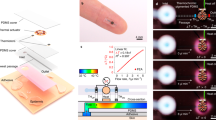Abstract
A new forced-evaporation type skin capsule for measuring local sweat gland activity in humans is described and details of its construction and problems of calibration are presented. The capsule is self-contained, portable, and inexpensive making it well suited for use in arrays to make multiple simultaneous determinations on adjacent skin areas. Sweat is evaporated from the skin surface by a stream of dry nitrogen gas; subsequent changes in capsule relative humidity and temperature are measured by a commercially available thin-film capacitance sensor and a solid-state current regulating device, respectively. These changes are measured within the capsule itself so no external water vapor analyzer is needed. Data acquisition and evaporation rate calculations are handled by an on-line microcomputer.
Similar content being viewed by others
References
Adams T., G.E. Funkhouser, and W.W. Kendall. Measurement of evaporative water loss with a thermal conductivity cell.J. Appl. Physiol. 18:1291–1292, 1963.
Brengelmann, G.L., M. McKeag, and L.B. Rowell. Use of dew point detection for quantitative measurement of sweating rate.J. Appl. Physiol. 39:498–500, 1975.
Bullard, R. Continuous recording of sweating rate by resistance hygrometry.J. Appl. Physiol. 17:735–737, 1962.
Foster, K.G. and J.S. Weiner. The continuous monitoring of sweat secretion in man and cat using a ventilated capsule and infrared analyzer.J. Physiol. London 191:1–2P, 1967.
Gasselt, H.R.M. and R.R. Vierhout. Registration of the insensible perspiration of small quantities of sweat.Dermatologica 127:255–259, 1963.
Harrison, D.R. and J. Dimeff. A diode-quad bridge circuit for use with capacitance transducers.Rev. Sci. Instrum. 44:1468–1472, 1973.
Kraning K.K. Combined effects of local cholinergic stimulation and beta-adrenergic blockade on sweat gland recruitment.Physiologist 24(4): 14, 1981 (Abstract).
Kraning, K.K., E.G. Schibli, S.T. Momii, and E.A. Merrick. A gas-stream heater to control local skin temperature under evaporative sweat capsules.J. Appl. Physiol.: Respir. Environ. Exercise Physiol. 44: 981–985, 1978.
Misevich, K.W. Capacitive humidity transducers.IEEE Trans. Ind. Electron. Control Instrum. 16:6–12, 1969.
Nilsson, G.E. Measurement of water exchange through the skin.Med. Biol. Eng. Comput. 15:209–218, 1977.
Timko, M.P. A two-terminal IC temperature transducer.IEEE J. Solid-State Circuits SC-11:784–788, 1976.
Weast, R.C. and M.J. Astle (editors).CRC Handbook of Chemistry and Physics, 61st Edition. Boca Raton, FL: CRC Press Inc., 1980, pp. E41-E44.
Author information
Authors and Affiliations
Rights and permissions
About this article
Cite this article
Kraning, K.K., Sturgeon, D.A. Measurement of sweating rate with capacitance sensors. Ann Biomed Eng 11, 131–146 (1983). https://doi.org/10.1007/BF02367496
Issue Date:
DOI: https://doi.org/10.1007/BF02367496




